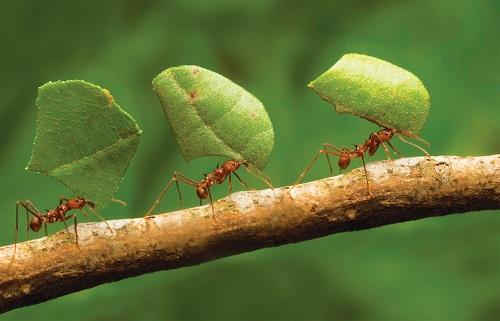(单词翻译:单击)
听力文本
This is Scientific American — 60-Second Science. I'm Karen Hopkin.
Got a minute?
Next time you need directions, maybe ask an ant. Because these clever little critters are such masters of navigation that some can find their way home… whether they're walking forward, backward, or sideways. That's according to a study in the journal Current Biology.
Ants often travel long distances—well, for them—when they're searching for food to bring back to their nests. And their built-in GPS appears to function just fine even when they wind up having to travel in reverse because they're dragging a huge morsel. But how do these backward bugs know where they're going?
To find out, researchers went to Spain to mess with some desert ants. They found an active nest and surrounded it with barriers that forced the foraging ants to follow a particular path back home. Once the ants were familiar with the maze, the researchers would scoop them up...hand them a cookie crumb...and then put them back in a different location...one that required taking a 90 degree turn to get to the nest.

What the researchers saw was that the ants that were carting a small, easy-to-carry crumb would dash forward with confidence and were able to hook a right and head on home. Presumably because they could see where they were going and recognized the route.
But some of their nest-mates were given a cookie crumb so large that they had to travel aft-first, pulling their prize behind them. These ants would set off in the correct general direction. But those that stuck with going in reverse would miss the turnoff to the nest.
Some of the rearward ants, however, stopped to get their bearings. They would drop the cookie and turn around to take a look at the landscape. This quick peek allowed the six-legged savants to reset their inner maps. So that after turning back around to grab their cookies they headed in the right direction, even going back-end first.
The ants-in-reverse appear to use celestial cues...like the position of the sun...to keep them on the straight and narrow. When the researchers used a mirror to make it look like the sun was on the other side of the sky, the beleaguered backward ants would turn tail for the opposite direction.
So ants integrate a lot of information...about local landmarks, the position of the sun, and where their bodies are situated in space...to successfully bring home the bacon... all while going backwards.
Lead author Antoine Wystrach, a CNRS researcher at the University of Toulouse 3, adds:
"This behavior is interesting in itself, as it implies a synergy between at least three types of memory: the long-term memories of the route sceneries, the memory of the new direction to follow, and the memory of the cookie left behind."
Thanks for listening for Scientific American — 60-Second Science Science. I'm Karen Hopkin.
参考译文
这里是科学美国人——60秒科学。我是凯伦·霍普金。
有一分钟时间吗?
下次你需要辨别方向时,也许可以问问蚂蚁。因为这些聪明的小生物是导航专家,无论它们向前走、向后走或是走小路,一些蚂蚁总能找到回家的路。该研究结果发表在《当代生物学》期刊上。
蚂蚁在寻找食物并把食物带回巢穴时经常要长途跋涉,对它们来说算是很远的距离了。它们身体里内置的定位系统运行良好,甚至在它们因为拖着一个巨大的食物碎屑而不得不掉头回家时也能正常发挥功能。但是,这些向后掉头的蚂蚁是如何知道它们要去哪里的呢?
为了找到答案,研究人员前往西班牙对一些沙漠蚂蚁进行了研究。他们发现了一个活跃的巢穴,他们用障碍物把这个巢穴围了起来,这迫使觅食蚂蚁沿着一条特定的路径回家。一旦这些蚂蚁熟悉了这种迷宫式的路线,研究人员就会把它们拿起来,给它们一块饼干碎屑,然后再把它们放到一个不同的位置,这个位置需要90度转弯才能返回巢穴。
研究人员发现,那些拿着小块且容易携带的食物碎屑的蚂蚁自信地向前突进,而且它们能找到正确的回家方向。这可能是因为它们能看到它们要去的地方并能识别出路线。
可是巢穴中有些同伴得到的是非常大的食物碎屑,所以它们不得不拖着食物跟着前面的蚂蚁走。这些蚂蚁可以朝着正确的方向前进。但是那些坚持往反方向走的蚂蚁则会错过回巢穴的岔道。
不过,后面的一些蚂蚁会停下来寻找方向。它们会扔下食物,转身查看一下四周的情况。这种快速查看可以使六条腿的蚂蚁重置地图。然后它们会转回去拿起它们的饼干碎屑,随后向着正确的方向前进,它们甚至能最先返回巢穴。
这些反转的蚂蚁似乎利用了天空中的线索,比如太阳的位置等,来使它们保持正确的路线。当研究人员用镜子让太阳看起来像在天空的另一边时,落后的蚂蚁会因为受到困扰而掉头向相反的方向前进。
所以,蚂蚁整合了大量信息,比如当地地标、太阳的位置、以及它们自己在空间中的位置等等,然后才能成功地把肉带回家。
该文章的第一作者安东尼·外斯奇是图卢兹第三大学法国国家科学研究中心的研究员,他补充道:
“这个行为本身就很有趣,因为它说明了至少三种类型的记忆之间的协同现象:路线周边的长期记忆、向新方向走的记忆,以及此前曾留下食物的记忆。”
谢谢大家收听科学美国人——60秒科学。我是凯伦·霍普金。
译文为可可英语翻译,未经授权请勿转载!
重点讲解
重点讲解:
1. wind up 最终落得;(以…)告终;
例句:He'll probably wind up being very well-heeled.
他也许最终会发财。
2. be familiar with 熟悉;熟知;
例句:People are familiar with the soundness of the poet's taste.
人们熟悉这位诗人风格的保守性。
3. scoop up (敏捷地)抱起,拿起,捡起;
例句:Use both hands to scoop up the leaves.
用双手捧起叶子。
4. set off 动身;出发;启程;
例句:She shouldered her rucksack and set off along the road.
她背起帆布背包就上路了。
5. leave behind 留下;余留;
例句:Do not leave behind any personal belongings.
请不要遗忘随身所带的物品。


